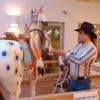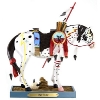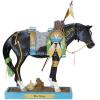
Hood, Rance
Over the summer of 2001, when the original life-size Painted Ponies were on public exhibition around New Mexico, a young attorney by the name of Boaz Weinstein became fascinated by The Trail of Painted Ponies, and taped a series of interviews with various Painted Pony artists. What follows is an edited version of his interview with the Comanche artist Rance Hood.
I'm a Comanche Indian from Lawton, Oklahoma. My grandmother and grandfather were full-blooded Comanche. When I was little, we didn't have electricity, no TV, just a lot of horses. My brother and I, if we weren't riding horses we were trying to ride something meaner, like bulls. I love horses. Love the smell of them. Know every damn bone in them. I was on the rodeo circuit for awhile.
When I was little I would sketch in the sand. We were poor. Didn't have no paper or pencil. We'd see army trucks going by and I'd sketch army trucks. My grandmother said you shouldn't do that, you should paint teepees, and she sketched a teepee on the ground for me. So I started doing that. Soon I had huge murals of Indian camps painted on the ground.
The first painting I ever done, I showed some friends and they all laughed. So I backed off for awhile. Then I started doing it again. On the sly. Ken, my brother, he's a truck driver, he's the one who got me started. We went to this ten cent store and he got me a can of multi-color watercolors with a paint brush and it cost a whole nineteen cents, or something like that. He said, "Here you go." So I painted a couple more pieces and showed them to my friends again. They said, "Damn, you got better." One painting was of a fancy dancer, and one of my friends asked me, "How much you want for it?" I said, "You got to be kidding." I didn't even know you could sell paintings. Well, the first Rance Hood original sold for fifteen bucks. You got to start somewhere, you know.
The inspiration for my work comes from the old people. My grandfather was a medicine man. My grandmother, she done a lot of geometric designs with beads. They would tell me stories at night of the Indian ways, and I could see what they were saying. That's why I stay with the traditional work. It's all a vision of what my grandmother and grandfather told me a long time ago, and I don't want to let that go. It would be like leaving them behind, and I don't want to do that.
When my grandfather passed away he handed me down the medicine. I sleep in a room full of it, and I pray a lot. Every morning and every evening, in the medicine ways. A lot of times I get visions when I'm sleeping. They're not a dream. They're different. When I work around medicine I'll get a vision or a title and I'll see the scene and paint it.
Warrior horses are my statement. I called the Painted Pony I did "War Pony" because the Comanche were a warrioring people. The "War Pony", when you ride him, he knows you and you know him and he's not going to default on you, he's not going to back out. Like I've had some friends in a bar fight who've backed out. If I had "War Pony" in there with me, he wouldn't back out. He'd die with me.
"War Pony" is an Appaloosa. We had Appaloosas in the Comanche tribe because the Comanche went up to Oregon and stole them from the Nez Perce. They're the ones who originated the Appaloosa horses. Sometimes the dots on an Appie are blue, sometimes they're gray, so I started doing that, without marking them first. I just knew where the spots were going to be. I'm a horse person.
We put a Comanche saddle on him. It's called a "woman's saddle". The warriors would put the women on them when they were pregnant, so they'd have something to hang onto. The men didn't hang onto nothing but the mane. There's also a shield with a buffalo on it and a lightning streak in the center. During the time when he was getting his medicine, a warrior would spend four days away on a hill. He'd see buffalo and put the buffalo on his shield for protection, and the same with lightning. The mane has real horse hair. A good friend of mine, name of Bear, he donated it and the buffalo hide.
The four eagle feathers are for the four prayers: East, West, South and North. In the Indian way, it means red, yellow, black and white. All the people that's on the Earth. Eagle feathers were the closest thing to God. We stuck eagle feathers on the tail and on the coup stick. The coup stick was just to touch the enemy and show bravery.
Back home in the Indian world, there's a lot of people who don't know how far you can go as a painter. It's not the thing to do. It's not wise, but for me it has been.
The original War Pony is currently on display at the Comanche Tribe's Visitor Center in Lawton, Oklahoma.
Current Painted Pony Figurines by Rance Hood:
- War Pony, a collectible figurine inspired by Rance Hood's original Pony "War Pony".
- War Magic, a Collaboration Collection figurine inspirired by the original "War Pony."
Additional Information
Residence:
Dennison, Texas... it's also Dwight Eisenhower's birthplace.
Biggest Artistic Influence:
Jackson Pollack. Love his work. Love his "slash and drip" technique. I use a lot of his abstract motifs in my backgrounds.
Favorite Song:
The blues. Everything by Albert King and B. B. King.
Favorite Color: What else? Blue.
Favorite Words of Advice: Have a good attorney.
Personal Hero: All my horses are heroes. I play, bet, win and ride horses.



